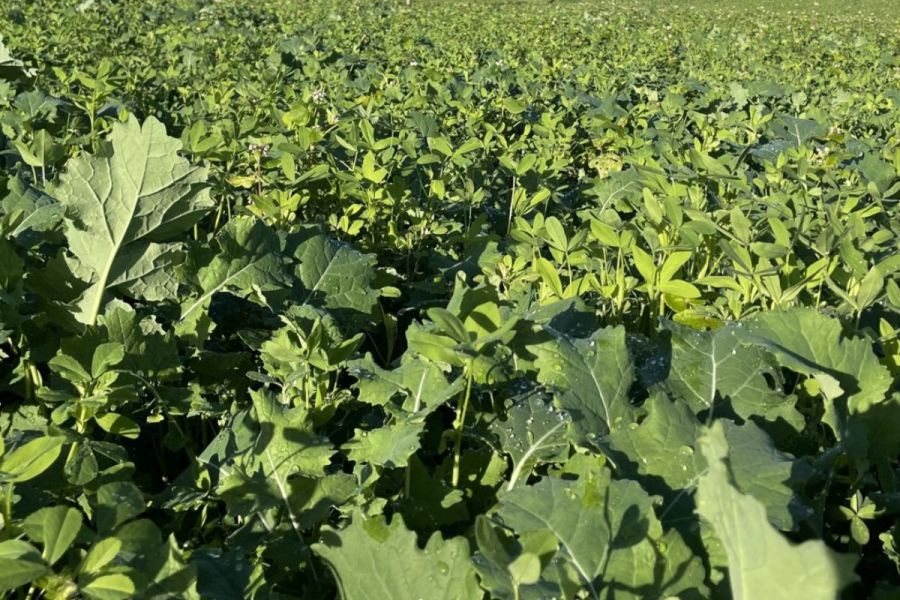
Download PDF
When it comes to adopting agroecological principles, the destination may be the same but the journey there is different for everyone. CPM attends Hutchinsons’ inaugural Agroecology conference to hear perspectives on how to plan the route.
By Lucy de la Pasture
As the UK’s largest agronomy company, the opening words from Hutchinsons’ head of agroecology, Ed Brown, at its inaugural Agroecology Conference may be a surprise to some people. He promises the 220 farmers present, independent and trustworthy advice without a string of inputs attached.
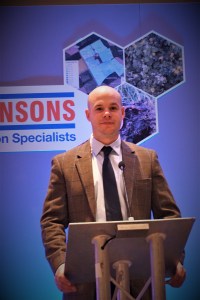
There’s growing interest in agroecology, says Ed Brown, and the Helix outcomes allow everyone to learn from other people’s mistakes.
That’s supported by an increasingly strong portfolio of services with dovetail with its agroecology services, which includes environment, soils, digital farming, farm business management and carbon, he says.
“Then we have the Helix farms – where theories are put into practice and we share what we’ve learned. These give the big picture outcomes and means everyone can learn from mistakes as well as the things that have gone right.
“But in order to reach agroecological objectives, it can’t be a big shift. There has to be a well-planned transition,” adds Ed.
Unsurprisingly, understanding your soil is the starting point for any transition, believes Ian Robertson, Hutchinsons’ head of soils.
“Most people have an idea of where they want to get, but unless you know where you’re starting from, you don’t know which direction to go, what to do first, where to work and what needs to be addressed.
“Establishing the starting point enables you to make an action plan. But fundamentally, what we can’t do is fall into the trap of trying to do everything at once.”
Ian warns about following the latest trends and highlights the failure of direct drilling in the 1980s as an example. “There’s no one silver bullet. And the reason why is because you’re all farming with different aspirations. You’re all farming different soils and you’ve got different skill sets. There’s lots of differences, which is a good thing, but that means it makes it harder because you need to understand an awful lot.”
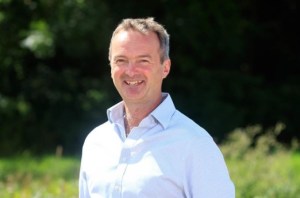
Ian Robinson reminds delegates that they’re actually growing biology, which is fundamental to everything.
And that’s where baselining provides the information needed to begin the transition, believes Ian. He quotes Lao Tzu: ‘The journey of a thousand miles begins with just one step.’ “And the biggest step I’ve seen on farm over the past 10-15 years, isn’t about machines. It’s about ‘noodles’ – it’s a headspace movement.”
Baselining the soil means looking at its three pillars – physical, chemical and biological – and understanding what those mean in terms of the growing crop, explains Ian.
“Physics, chemistry, and biology – they all work together, you can’t separate them. But as an industry, we’ve been really clever at separating them and we’ve been focusing on physics and chemistry.”
Biology is missing, he highlights. “The reason I think we’ve not done a lot with biology is that it can be very difficult to see. But biology is fundamental to everything, microbes started to associate with plants 590M years ago. We’re actually growing biology.”
But Ian points out that understanding the soil chemistry alludes to its biology and physics. It gives clues as to how the soil is functioning and cycling nutrients. These clues can be followed and lead to solutions to improve them, potentially making more nutrients in the soil available to plants.
“Baselining helps every decision you will make on the farm – for example, about cultivation and establishment; rotations; soil and crop strategy; catch and cover crops; livestock integration and manures; and machinery requirements. Guessing these won’t lead to optimum economic outcomes,” he says.
First steps into agroecology
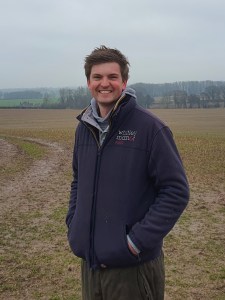
Harry Heath explains some of the factors that led him to change the way he farms, transitioning to a more agroecological approach.
Harry Heath reached the decision to change his farming practices to an agroecological approach in 2018-19. He’s still near the beginning of his journey and hosts the Helix agroecology initiative on his farm near Newport in Shropshire.
“It’s great, because we get to try lots of things and it really pushes me on to try more,” says Harry.
The farm’s primary enterprise has always been indoor pigs but the decision has been made to move out of the sector and, instead, run a smaller outdoor herd on the farm’s sandy soils, he explains. The arable side of the business has now become its mainstay and Harry stresses that agroecology, and the ability to farm long-term with profit and sustainability, form its new foundations.
“Before we re-evaluated things, our cultivation practices were very, very intensive. We were still rotationally ploughing and we were combination drilling. We were sub-soiling everything and on our sandy soils, the more we did, the more we had to do to artificially create a soil structure.
And as time progressed, both my father, Martin, and myself started to feel that we were taking a lot more from the land than we were actually giving back and we had no connection with the biology that’s so important,” he says.
Harry’s ‘aha’ moment, which brought home the dangers of recreational tillage, came when the farm was still growing potatoes and he shows a photo to the delegates.
“This is the photo which acts as a sombre reminder of what happens when you do recreational tillage on our farm. It’s light sand and this was a field where potatoes had been lifted. We thought it was the right thing in those early days to go in and subsoil and then put a tined cultivator back through it.
“Then, in the middle of August we had 130-150ml of rain in about three hours and about 2000-3000 tonnes of soil ran down that hill and ended up at the bottom of the valley. So we got a bulldozer and pushed it all back up and carried on.”
In 2018-19, the decision was made to take potatoes out of the rotation because of where the farm’s soil heath had got to. “We did some soil baseline tests, just to put a line in the sand of where we were, so that we could work out how to get the basics right.”
Harry says he also felt he was on a bit of a treadmill which he wanted to get off and that’s where agroecology came in. “I wanted to start to pull back inputs – in terms of nitrogen, fungicides, insecticides – and at the time, I was very inspired by those people who are doing that and I still continue to be so today. But what I loved about it was that it was a low-risk model and getting off that treadmill. And actually, that’s really where I wanted to be.
“Changing our focus by moving from out and out yield, which is what we used to focus on, to profit was a big step. Our light land tends to go very tight, so even though we’ve bought a direct drill to enable us to step back from cultivation, it’s a gradual process.
“A cornerstone of agroecology for us is keeping the ground covered with catch or cover crops. We’re also growing companion crops to add diversity; for example, planting buckwheat and clover with oilseed rape. It also bridges the gap because OSR doesn’t make mycorrhizal associations. But we’re also growing spring beans with spring oats.”
Adding diversity extends to the genetics of crops so Harry has had blends of wheat on the farm for the past couple of years. “Probably the biggest thing for us is that it’s allowing us that flexibility to try and step away from fungicides more, as well as try and have some genetic diversity in amongst the crop,” he comments.
Being part of the Helix network has enabled Harry to take a measured approach to trying new things on the farm, with a trials programme that’s been set up to properly evaluate whether techniques are making a positive contribution or not. This year’s trials include looking at biological extracts, with a Johnson Su reactor providing the goodies. Further trials are investigating primed seed, nitrogen rates, blends and Harry’s overall objective of decreasing glyphosate use on the farm.
“We need to understand and continually re-evaluate what our management impacts are on soil health so that we know we’re moving in the right direction. Now, we’ve definitely reaffirmed we’re reconnecting with the biology. And that really just means that we’ve got to be working with nature all the time and not working against it, because that’s ultimately really where we might have been going wrong in the past.”
#getonmyland
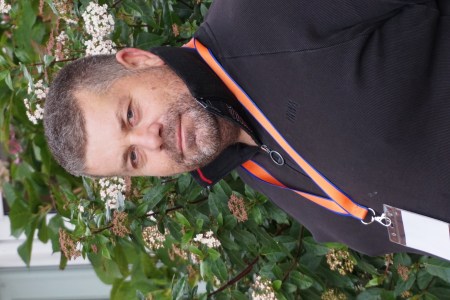
Ben Taylor-Davies has turned entrenched thinking on its head at his family farm, near Ross-on-Wye. He positively encourages the public to #getonmyland.
At the other end of the spectrum is experienced agroecology consultant Ben Taylor-Davies, who has embodied its practices at Townend Farm, near Ross-on-Wye in Herefordshire. In fact, you could say there’s not much conventional about the way Ben thinks but his approach is actually to keep things simple.
“We focus massively on appreciation of appreciation. And we’re going to touch on what we do and how we do that.
Pointing to a photo of the farm, Ben says that his 220ha has received £1.2 million in farm benefits since 1993. “I therefore think the general public probably has a right to come and have a look what we’ve done with what I consider taxpayers money. And therefore look at the public a little bit differently than most.”
Ben has the hashtag ‘getonmyfarm’ because he views the public as an integral part of his farming business. “We’ve got the farm shop. We have farm notice boards all over the farm. And we’re running farm walks all the time – walks for a cardiovascular workout, a yellow walk for art – with sculptures and paintings. We have a nature trail and corners of the farm for quiet time,” he says.
“When we start engaging with the general public, funnily enough, they engage back. Our farm is becoming the centre of the community again, as it once was in the 1930s. We’re having gatherings, whether it be Bonfire Night, whether it be Christmas Carols, we do all these sorts of things. Therefore, for me, this journey goes far beyond so far behind what we’re producing. But actually when you start listening and asking the questions of your local community, it’s amazing how much they will come and support what you’re doing.”
Ben’s engagement goes beyond the local community. “I’m finding as I’m engaging with more NGOs in demonstrations and things we’re doing on the farm to actually show what can be done, that great people are actually offering solutions. We also invite policymakers, there’s no point in moaning about policy, if you’re not being the person to say, come to my farm, come and listen to my problems.”
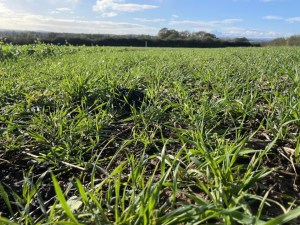
Ben planted perennial Kernza winter wheat last autumn, which should provide a harvest for the next 15 years.
The next thing about reinventing everything is diversity, diversity, diversity. Typically Ben thinks out of the box when it comes to creating diversity on his farm.
“My father spent his lifetime specialising his farm because it became less risky. So in actual fact, what we’re doing here is doing the absolute opposite. I want to be a jack of all trades, and certainly a master of none. I want to unspecialise to spread my risk.
Diversity comes in many shapes and sizes and ben’s unconventional thread even runs through his new agroforestry strips where he has an eye on the future, planning for a warming climate.
“Our agroforestry scheme is underway and we’ve planted tea and olives. This is not for me, it’s probably not for my children but for my great grandchildren. Is there going to be a scenario where actually olives are going to be a really nice sustainable crop for generations to come?”
Ben’s believes diversity applies as much to the animals on the farm as to the crops. That’s why he has a ‘flerd’ and he’s found this mixed bunch can play an important role in pruning the grapevines in the farm’s Hands Off vineyard
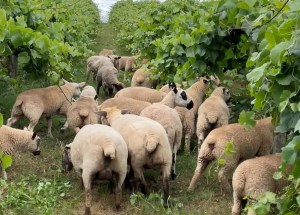
At Townsend Farm, the flerd take responsibility for pruning and mowing the vineyard. Photo: Ben Taylor-Davies.
He’s also moved beyond reliance on glyphosate and instead utilises the green for integration of his livestock or flerd. “Slugs thrive on thin and decaying material. They also thrive on the very new shoots of any emerging plant because of their very basic sugars. So it stands to reason if you ever want to attract slugs, then spray off cover crops with glyphosate and then plant a brand-new crop into it.
Ben has been experimenting with regenerative potatoes for several years and believes that, for the first time ever, he’s grown carbon negative potatoes across 35 hectares. He also says he has the first commercial crop of Kernza perennial wheat in the ground. “We planted it in September and we’re going to harvest every year for hopefully the next 15 years.”
Involving people in the business is what Ben does best, and none more so than his family who are as much a part of its success as he is. “I’m a family farmer, which means our family farms,” he concludes.





